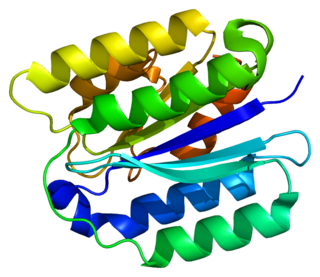Mucolipidosis type IV is an autosomal recessive lysosomal storage disorder. Individuals with the disorder have many symptoms including delayed psychomotor development and various ocular aberrations. The disorder is caused by mutations in the MCOLN1 gene, which encodes a non-selective cation channel, mucolipin1. These mutations disrupt cellular functions and lead to a neurodevelopmental disorder through an unknown mechanism. Researchers dispute the physiological role of the protein product and which ion it transports.

Mucolipin-1 also known as TRPML1 is a protein that in humans is encoded by the MCOLN1 gene. It is a member of the small family of the TRPML channels, a subgroup of the large protein family of TRP ion channels.

Short transient receptor potential channel 5 (TrpC5) also known as transient receptor protein 5 (TRP-5) is a protein that in humans is encoded by the TRPC5 gene. TrpC5 is subtype of the TRPC family of mammalian transient receptor potential ion channels.

Transient receptor potential cation channel subfamily M member 3 is a protein that in humans is encoded by the TRPM3 gene.

Prokineticin receptor 1, also known as PKR1, is a human protein encoded by the PROKR1 gene.

G-protein coupled receptor 161 is a protein that in humans is encoded by the GPR161 gene.

Cytoplasmic tyrosine-protein kinase BMX is an enzyme that in humans is encoded by the BMX gene.

Gamma-aminobutyric acid receptor subunit beta-1 is a protein that in humans is encoded by the GABRB1 gene.

Anthrax toxin receptor 2 is a protein that in humans is encoded by the ANTXR2 gene.

Aquaporin-5 (AQP-5) is a protein that in humans is encoded by the AQP5 gene.

Disks large-associated protein 4 (DAP-4) also known as SAP90/PSD-95-associated protein 4 (SAPAP-4) is a protein that in humans is encoded by the DLGAP4 gene.

Olfactory receptor 6A2 is a protein that in humans is encoded by the OR6A2 gene. It is Class II (tetrapod-specific) olfactory receptor and a rhodopsin-like receptor.

Olfactory receptor 2K2 is a protein that in humans is encoded by the OR2K2 gene.

Olfactory receptor 10H3 is a protein that in humans is encoded by the OR10H3 gene.

Olfactory receptor 7A5 is a protein that in humans is encoded by the OR7A5 gene.

Olfactory receptor 7C2 is a protein that in humans is encoded by the OR7C2 gene.

Mucolipin-2 also known as TRPML2 is a protein that in humans is encoded by the MCOLN2 gene. It is a member of the small family of the TRPML channels, a subgroup of the large protein family of TRP ion channels.

Polycystic kidney disease 2-like 2 protein (PKD2L2) also known as transient receptor potential polycystic 5 (TRPP5) is a protein that in humans is encoded by the PKD2L2 gene.

Guanine nucleotide-binding protein G(t) subunit alpha-3, also known as gustducin alpha-3 chain, is a protein subunit that in humans is encoded by the GNAT3 gene.

Enkurin is a protein that in humans is encoded by the ENKUR gene.


















